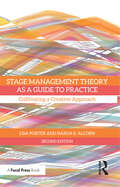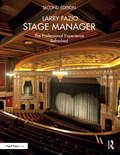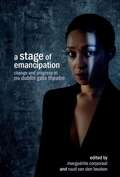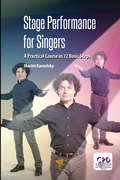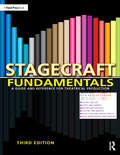- Table View
- List View
Stage Management Theory as a Guide to Practice: Cultivating a Creative Approach
by Lisa Porter Narda E. AlcornStage Management Theory as a Guide to Practice offers theory and methodology for developing a unique stage management style, preparing stage managers to develop an adaptive approach for the vast and varied scope of the production process, forge their own path, and respond to the present moment with care and creativity. This book provides tactile adaptive strategies, enabling stage managers to navigate diverse populations, venues, and projects. Experiential stories based on extensive experience with world-renowned artists exemplify the practices and provide frameworks for self-reflection, synthesis, and engagement with theory-guided practice. This book empowers stage managers to include the ‘How You’ with ‘How To’ by flexing collaborative muscles and engaging tools to guide any collaborative project to fruition with creativity, curiosity, and the drive to build connections. Exploring topics such as group dynamics, ethics, culture, conflict resolution, and strategic communication, Stage Management Theory as a Guide to Practice: Cultivating a Creative Approach is an essential tool for advanced stage management students, educators, and professionals.
Stage Management Theory as a Guide to Practice: Cultivating a Creative Approach
by Lisa Porter Narda E. AlcornStage Management Theory as a Guide to Practice, Second Edition offers theory and methodology for developing a unique and inclusive stage management style, preparing stage managers to develop an adaptive approach for the vast and varied scope of the production process, forge their own path, and respond to the present moment with care and creativity. This book provides tactile strategies, enabling stage managers to navigate different groups of collaborators, venues, and projects. Experiential stories based on extensive experience with world-renowned artists exemplify the practices and provide frameworks for self-reflection, synthesis, and engagement with theory-guided practice. This book empowers stage managers to guide any collaborative project to fruition by incorporating the "How You" with the "How To." This second edition has been expanded, and includes new experiential stories and a new chapter focused on inclusive processes that can be applied from pre-production through closing, as well as the full text of the HowlRound Theatre essay We Commit to Anti-Racist Stage Management Education. Exploring topics such as group dynamics, ethics, culture, and strategic communication, Stage Management Theory as a Guide to Practice is an essential tool for advanced stage management students, educators, and professionals.
Stage Management Theory as a Guide to Practice: Cultivating a Creative Approach
by Lisa Porter Narda E. AlcornStage Management Theory as a Guide to Practice, Second Edition offers theory and methodology for developing a unique and inclusive stage management style, preparing stage managers to develop an adaptive approach for the vast and varied scope of the production process, forge their own path, and respond to the present moment with care and creativity. This book provides tactile strategies, enabling stage managers to navigate different groups of collaborators, venues, and projects. Experiential stories based on extensive experience with world-renowned artists exemplify the practices and provide frameworks for self-reflection, synthesis, and engagement with theory-guided practice. This book empowers stage managers to guide any collaborative project to fruition by incorporating the "How You" with the "How To." This second edition has been expanded, and includes new experiential stories and a new chapter focused on inclusive processes that can be applied from pre-production through closing, as well as the full text of the HowlRound Theatre essay We Commit to Anti-Racist Stage Management Education. Exploring topics such as group dynamics, ethics, culture, and strategic communication, Stage Management Theory as a Guide to Practice is an essential tool for advanced stage management students, educators, and professionals.
Stage Manager: The Professional Experience—Refreshed
by Larry FazioStage Manager: The Professional Experience–Refreshed takes the reader on a journey through all aspects of the craft of stage management in theatre, including the technological advancements that have come to theatre and the stage manger’s job. Chapters are laid out to reflect the order in which stage managers experience and perform their work: what makes a good stage manager, seeking the job, building a resume, interviewing for the job, and getting the job (or not getting the job). Included are chapters on the chain of command, working relationships, tool and supplies, creating charts, plots, plans and lists, the rehearsal period, creating the prompt book, calling cues, and the run of the show. These are just some of the many topics covered in this book. In addition, the author uses interviews with stage management professionals in various stages of production, providing another view of how the stage manager is perceived and what is expected form the work of the stage manager. Fifteen years after the original publication of Stage Manager: The Professional Experience, this new and refreshed edition is now in color to help clarify and illustrate points in the text. It is fully updated to reflect the the world of computerized technology: smart phones, thinly designed laptops, tablets, use of email and text messaging, storing and sharing files and information in cloud-based apps. Then there are the innovations of automation–electronically moving scenery, scenic projections–casting images and patterns on the stage; moving lights; LED luminaires; lasers; and greater use of fog and haze machines. In addition, the extensive glossary of more than 600 terms and phrases had been extend to well over 700, providing and excellent professional vocabulary for anyone hoping to be a theatre stage manager or already working in the field.
Stage Manager: The Professional Experience—Refreshed
by Larry FazioStage Manager: The Professional Experience–Refreshed takes the reader on a journey through all aspects of the craft of stage management in theatre, including the technological advancements that have come to theatre and the stage manger’s job. Chapters are laid out to reflect the order in which stage managers experience and perform their work: what makes a good stage manager, seeking the job, building a resume, interviewing for the job, and getting the job (or not getting the job). Included are chapters on the chain of command, working relationships, tool and supplies, creating charts, plots, plans and lists, the rehearsal period, creating the prompt book, calling cues, and the run of the show. These are just some of the many topics covered in this book. In addition, the author uses interviews with stage management professionals in various stages of production, providing another view of how the stage manager is perceived and what is expected form the work of the stage manager. Fifteen years after the original publication of Stage Manager: The Professional Experience, this new and refreshed edition is now in color to help clarify and illustrate points in the text. It is fully updated to reflect the the world of computerized technology: smart phones, thinly designed laptops, tablets, use of email and text messaging, storing and sharing files and information in cloud-based apps. Then there are the innovations of automation–electronically moving scenery, scenic projections–casting images and patterns on the stage; moving lights; LED luminaires; lasers; and greater use of fog and haze machines. In addition, the extensive glossary of more than 600 terms and phrases had been extend to well over 700, providing and excellent professional vocabulary for anyone hoping to be a theatre stage manager or already working in the field.
The Stage Manager's Toolkit: Templates and Communication Techniques to Guide Your Theatre Production from First Meeting to Final Performance (The Focal Press Toolkit Series)
by Laurie KincmanThe Stage Manager’s Toolkit provides a comprehensive account of the role of the stage manager for live theatre with a focus on both written and verbal communication best practices. The book outlines the duties of the stage manager and assistant stage manager throughout a production, discussing not only what to do but why. The book identifies communication objectives for each phase of production, paperwork to be created, and the necessary questions to be answered in order to ensure success.
The Stage Manager's Toolkit: Templates and Communication Techniques to Guide Your Theatre Production from First Meeting to Final Performance (The Focal Press Toolkit Series)
by Laurie KincmanThe Stage Manager’s Toolkit provides a comprehensive account of the role of the stage manager for live theatre with a focus on both written and verbal communication best practices. The book outlines the duties of the stage manager and assistant stage manager throughout a production, discussing not only what to do but why. The book identifies communication objectives for each phase of production, paperwork to be created, and the necessary questions to be answered in order to ensure success.
The Stage Manager's Toolkit: Templates and Communication Techniques to Guide Your Theatre Production from First Meeting to Final Performance (The Focal Press Toolkit Series)
by Laurie KincmanThe Stage Manager’s Toolkit, Third Edition provides a comprehensive account of the role of the stage manager for live theatre with a focus on both written and verbal communication best practices. The book outlines the duties of the stage manager and assistant stage manager throughout a production, discussing not only what to do but why. It also identifies communication objectives for each phase of production, paperwork to be created, and the necessary questions to be answered in order to ensure success. This third edition includes: an updated look at digital stage management tools including script apps, cloud storage, and social media practices; a new discussion on creating a healthy and safe rehearsal space; updated paperwork examples; new information on Equity practices for the student and early career stage managers. Written for the stage management student and early career stage manager, this book is a perfect companion to any university Stage Management course. A companion website hosts customizable paperwork templates, instructional video, links to additional information, teacher tools for each individual chapter, and a bonus chapter on teaching stage management.
The Stage Manager's Toolkit: Templates and Communication Techniques to Guide Your Theatre Production from First Meeting to Final Performance (The Focal Press Toolkit Series)
by Laurie KincmanThe Stage Manager’s Toolkit, Third Edition provides a comprehensive account of the role of the stage manager for live theatre with a focus on both written and verbal communication best practices. The book outlines the duties of the stage manager and assistant stage manager throughout a production, discussing not only what to do but why. It also identifies communication objectives for each phase of production, paperwork to be created, and the necessary questions to be answered in order to ensure success. This third edition includes: an updated look at digital stage management tools including script apps, cloud storage, and social media practices; a new discussion on creating a healthy and safe rehearsal space; updated paperwork examples; new information on Equity practices for the student and early career stage managers. Written for the stage management student and early career stage manager, this book is a perfect companion to any university Stage Management course. A companion website hosts customizable paperwork templates, instructional video, links to additional information, teacher tools for each individual chapter, and a bonus chapter on teaching stage management.
A Stage of Emancipation: Change and Progress at the Dublin Gate Theatre
An Open Access edition of this book is available on the Liverpool University Press website and the OAPEN library. As the prominence of the recent #WakingTheFeminists movement illustrates, the Irish theatre world is highly conscious of the ways in which theatre can foster social emancipation. This volume of essays uncovers a wide range of marginalised histories by reflecting on the emancipatory role that the Dublin Gate Theatre (est. 1928) has played in Irish culture and society, both historically and in more recent times. The Gate’s founders, Hilton Edwards and Michéal mac Liammóir, promoted the work of many female playwrights and created an explicitly cosmopolitan stage on which repressive ideas about gender, sexuality, class and language were questioned. During Selina Cartmell’s current tenure as director, cultural diversity and social emancipation have also featured prominently on the Gate’s agenda, with various productions exploring issues of ethnicity in contemporary Ireland. The Gate thus offers a unique model for studying the ways in which cosmopolitan theatres, as cultural institutions, give expression to and engage with the complexities of identity and diversity in changing, globalised societies. CONTRIBUTORS: David Clare, Marguérite Corporaal, Mark Fitzgerald, Barry Houlihan, Radvan Markus, Deirdre McFeely, Justine Nakase, Siobhan O'Gorman, Mary Trotter, Grace Vroomen, Ian R. Walsh, Feargal Whelan
Stage Performance for Singers: A Practical Course in 12 Basic Steps
by Martin KarnolskyThere are about ten books in the world on stage performance training. Most of them are in English, but there are a few in Spanish. There are none in Russian, although the father of modern theater, Konstantin Stanislavski, was born in Russia. In singing, regardless of genre and style, the element of stage performance is missing. There is no normal training for communicating with the audience. It is accepted by most vocal pedagogues that it is enough to sing the notes correctly, but there is much more to do. For singers who study opera and operetta, it is essential to stretch the limits of performance, and that is why they also study acting. For everyone else, this is not necessary, because they have other tasks on stage. They must learn to self-regulate, not to wait for directional instructions. This book is valuable in that it teaches singers to direct their own stage performance. Representing the author’s conclusions based on careful analysis of a number of successful and unsuccessful stage performances of numerous singers of different stature, it gives them the basic knowledge and guidance on how to approach and develop their show from one song to one concert. It teaches singers how to be more successful on stage, how to be more charismatic and how to manage their audience the way they want.
Stage Performance for Singers: A Practical Course in 12 Basic Steps
by Martin KarnolskyThere are about ten books in the world on stage performance training. Most of them are in English, but there are a few in Spanish. There are none in Russian, although the father of modern theater, Konstantin Stanislavski, was born in Russia. In singing, regardless of genre and style, the element of stage performance is missing. There is no normal training for communicating with the audience. It is accepted by most vocal pedagogues that it is enough to sing the notes correctly, but there is much more to do. For singers who study opera and operetta, it is essential to stretch the limits of performance, and that is why they also study acting. For everyone else, this is not necessary, because they have other tasks on stage. They must learn to self-regulate, not to wait for directional instructions. This book is valuable in that it teaches singers to direct their own stage performance. Representing the author’s conclusions based on careful analysis of a number of successful and unsuccessful stage performances of numerous singers of different stature, it gives them the basic knowledge and guidance on how to approach and develop their show from one song to one concert. It teaches singers how to be more successful on stage, how to be more charismatic and how to manage their audience the way they want.
Stage-Play and Screen-Play: The intermediality of theatre and cinema
by Michael InghamDialogue between film and theatre studies is frequently hampered by the lack of a shared vocabulary. Stage-Play and Screen-Play sets out to remedy this, mapping out an intermedial space in which both film and theatre might be examined. Each chapter’s evaluation of the processes and products of stage-to-screen and screen-to-stage transfer is grounded in relevant, applied contexts. Michael Ingham draws upon the growing field of adaptation studies to present case studies ranging from Martin McDonagh’s The Cripple of Inishmaan and RSC Live’s simulcast of Richard II to F.W. Murnau’s silent Tartüff, Peter Bogdanovich’s film adaptation of Michael Frayn’s Noises Off, and Akiro Kurosawa’s Ran, highlighting the multiple interfaces between media. Offering a fresh insight into the ways in which film and theatre communicate dramatic performances, this volume is a must-read for students and scholars of stage and screen.
Stage-Play and Screen-Play: The intermediality of theatre and cinema
by Michael InghamDialogue between film and theatre studies is frequently hampered by the lack of a shared vocabulary. Stage-Play and Screen-Play sets out to remedy this, mapping out an intermedial space in which both film and theatre might be examined. Each chapter’s evaluation of the processes and products of stage-to-screen and screen-to-stage transfer is grounded in relevant, applied contexts. Michael Ingham draws upon the growing field of adaptation studies to present case studies ranging from Martin McDonagh’s The Cripple of Inishmaan and RSC Live’s simulcast of Richard II to F.W. Murnau’s silent Tartüff, Peter Bogdanovich’s film adaptation of Michael Frayn’s Noises Off, and Akiro Kurosawa’s Ran, highlighting the multiple interfaces between media. Offering a fresh insight into the ways in which film and theatre communicate dramatic performances, this volume is a must-read for students and scholars of stage and screen.
Stage Presence
by Jane GoodallFocusing on examples of live performance in drama, dance, opera and light entertainment, Jane Goodall explores a characteristic as compelling and enigmatic as the performers who demonstrate it. The mysterious quality of ‘presence’ in a performer has strong resonances with the uncanny. It is associated with primal, animal qualities in human individuals, but also has connotations of divinity and the supernatural, relating to figures of evil as well as heroism. Stage Presence traces these themes through theatrical history. This fascinating study also explores the blend of science and spirituality that accompanies the appreciation of human power. Performers display a magnetism of their audiences; they electrify them, exhibit mesmeric command, and develop chemistry in their communication. Case studies include: Josephine Baker, Sarah Bernhardt, Thomas Betterton, David Bowie, Maria Callas, Bob Dylan, David Garrick, Barry Humphries, Henry Irving, Vaslav Nijinsky and Paul Robeson.
Stage Presence
by Jane GoodallFocusing on examples of live performance in drama, dance, opera and light entertainment, Jane Goodall explores a characteristic as compelling and enigmatic as the performers who demonstrate it. The mysterious quality of ‘presence’ in a performer has strong resonances with the uncanny. It is associated with primal, animal qualities in human individuals, but also has connotations of divinity and the supernatural, relating to figures of evil as well as heroism. Stage Presence traces these themes through theatrical history. This fascinating study also explores the blend of science and spirituality that accompanies the appreciation of human power. Performers display a magnetism of their audiences; they electrify them, exhibit mesmeric command, and develop chemistry in their communication. Case studies include: Josephine Baker, Sarah Bernhardt, Thomas Betterton, David Bowie, Maria Callas, Bob Dylan, David Garrick, Barry Humphries, Henry Irving, Vaslav Nijinsky and Paul Robeson.
Stage Right
by John BullStage Right is a refreshingly abrasive account of the state of British theatre since 1979, offering an account of the development of a new mainstream formed in conscious opposition to the work of the politically committed dramatists of the 70s and an analysis of the plays of the most successful playwrights of the new mainstream: Nichols, Gray, Frayn, Bennett, Ayckbourn and Stoppard.
Stage rights!: The Actresses’ Franchise League, activism and politics 1908–58 (G - Reference, Information and Interdisciplinary Subjects)
by Naomi PaxtonStage rights! explores the work and legacy of the first feminist political theatre group of the twentieth century, the Actresses' Franchise League. Formed in 1908 to support the suffrage movement through theatre, the League and its membership opened up new roles for women on stage and off, challenged stereotypes of suffragists and actresses, created new work inspired by the movement and was an integral part of the performative propaganda of the campaign. Introducing new archival material to both suffrage and theatre histories, this book is the first to focus in detail on the Actresses' Franchise League, its membership and its work. The volume is formulated as a historiographically innovative critical biography of the organisation over the fifty years of its activities, and invites a total reassessment of the League within the accepted narratives of the development of political theatre in the UK.
Stage rights!: The Actresses’ Franchise League, activism and politics 1908–58 (Women, Theatre And Performance Ser.)
by Naomi PaxtonStage rights! explores the work and legacy of the first feminist political theatre group of the twentieth century, the Actresses' Franchise League. Formed in 1908 to support the suffrage movement through theatre, the League and its membership opened up new roles for women on stage and off, challenged stereotypes of suffragists and actresses, created new work inspired by the movement and was an integral part of the performative propaganda of the campaign. Introducing new archival material to both suffrage and theatre histories, this book is the first to focus in detail on the Actresses' Franchise League, its membership and its work. The volume is formulated as a historiographically innovative critical biography of the organisation over the fifty years of its activities, and invites a total reassessment of the League within the accepted narratives of the development of political theatre in the UK.
Stage women, 1900–50: Female theatre workers and professional practice (Women, Theatre and Performance)
by Maggie B. Gale Kate DorneyThis book presents a collection of cutting-edge historical and cultural essays in the field of women, theatre and performance. The chapters explore women’s networks of professional practice in the theatre and performance industries between 1900 and 1950, with a focus on women’s sense and experience of professional agency in an industry largely controlled by men. The book is divided into two sections: ‘Female theatre workers in the social and theatrical realm’ looks at the relationship between women’s work – on and off stage – and autobiography, activism, technique, touring, education and the law. ‘Women and popular performance’ focuses on the careers of individual artists, once household names, including Lily Brayton, Ellen Terry, radio star Mabel Constanduros and Oscar-winning film star Margaret Rutherford.
Stage women, 1900–50: Female theatre workers and professional practice (Women, Theatre and Performance)
by Maggie B. Gale Kate DorneyThis book presents a collection of cutting-edge historical and cultural essays in the field of women, theatre and performance. The chapters explore women’s networks of professional practice in the theatre and performance industries between 1900 and 1950, with a focus on women’s sense and experience of professional agency in an industry largely controlled by men. The book is divided into two sections: ‘Female theatre workers in the social and theatrical realm’ looks at the relationship between women’s work – on and off stage – and autobiography, activism, technique, touring, education and the law. ‘Women and popular performance’ focuses on the careers of individual artists, once household names, including Lily Brayton, Ellen Terry, radio star Mabel Constanduros and Oscar-winning film star Margaret Rutherford.
Stage women, 1900–50: Female theatre workers and professional practice (Women, Theatre and Performance)
by Maggie B. Gale and Kate DorneyThis book presents a collection of cutting-edge historical and cultural essays in the field of women, theatre and performance. The chapters explore women’s networks of professional practice in the theatre and performance industries between 1900 and 1950, with a focus on women’s sense and experience of professional agency in an industry largely controlled by men. The book is divided into two sections: ‘Female theatre workers in the social and theatrical realm’ looks at the relationship between women’s work – on and off stage – and autobiography, activism, technique, touring, education and the law. ‘Women and popular performance’ focuses on the careers of individual artists, once household names, including Lily Brayton, Ellen Terry, radio star Mabel Constanduros and Oscar-winning film star Margaret Rutherford.An electronic edition of this book is freely available under a Creative Commons (CC BY-NC-ND) licence.
Stage women, 1900–50: Female theatre workers and professional practice
This electronic version has been made available under a Creative Commons (BY-NC-ND) open access license. This book presents a collection of cutting-edge historical and cultural essays in the field of women, theatre and performance. The chapters explore women’s networks of professional practice in the theatre and performance industries between 1900 and 1950, with a focus on women’s sense and experience of professional agency in an industry largely controlled by men. The book is divided into two sections: ‘Female theatre workers in the social and theatrical realm’ looks at the relationship between women’s work – on and off stage – and autobiography, activism, technique, touring, education and the law. ‘Women and popular performance’ focuses on the careers of individual artists, once household names, including Lily Brayton, Ellen Terry, radio star Mabel Constanduros and Oscar-winning film star Margaret Rutherford.
Stagecraft Fundamentals: A Guide and Reference for Theatrical Production
by Rita Kogler CarverStagecraft Fundamentals tackles every aspect of basic theatre production with Rita Kogler Carver’s signature wit and engaging voice. The history of stagecraft, safety precautions, lighting, costumes, scenery, career planning tips, and more are discussed, illustrated by beautiful color examples that both display step-by-step procedures and break with the traditionally boring black and white introductory theatre book. This third edition improves upon the last, featuring three new chapters on design for props, projection, and touring. Also included are new end-of-chapter questions and an expanded discussion on LED lighting, stage automation, digital technology, stage management, makeup, theatre management, and sound design. This is the must have introductory theatre production book.
Stagecraft Fundamentals: A Guide and Reference for Theatrical Production
by Rita Kogler CarverStagecraft Fundamentals tackles every aspect of basic theatre production with Rita Kogler Carver’s signature wit and engaging voice. The history of stagecraft, safety precautions, lighting, costumes, scenery, career planning tips, and more are discussed, illustrated by beautiful color examples that both display step-by-step procedures and break with the traditionally boring black and white introductory theatre book. This third edition improves upon the last, featuring three new chapters on design for props, projection, and touring. Also included are new end-of-chapter questions and an expanded discussion on LED lighting, stage automation, digital technology, stage management, makeup, theatre management, and sound design. This is the must have introductory theatre production book.

